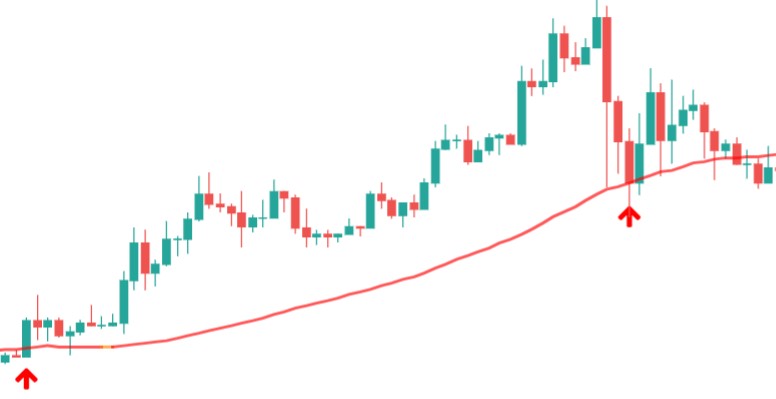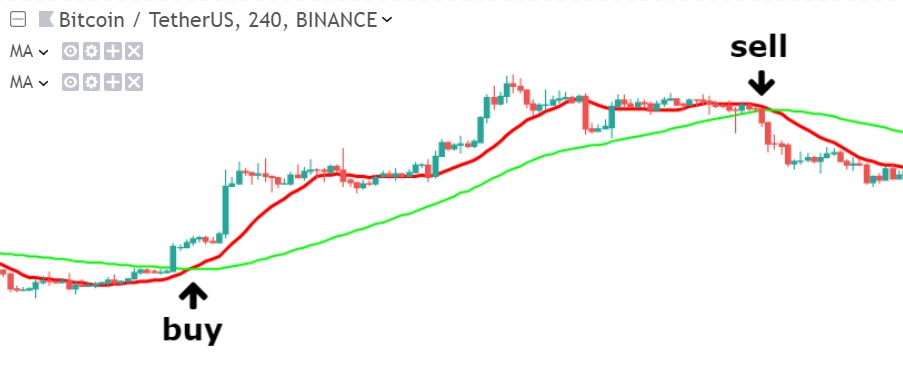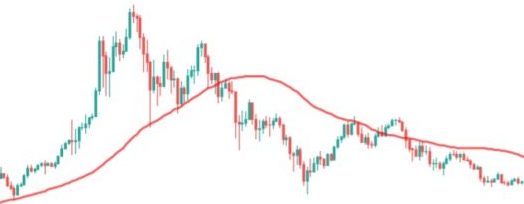Moving averages (MA) are one of the most used instruments by technical analysts. A moving average is an instrument that can smooth out price movement in a less noisy average line. It is always calulated over a previous period.
For example the 50 period moving average. This is the average price over the previous 50 candles. You take the last 50 closing prices, addd them up, and then divide them by 50. As price moves forward 1 candle, the moving average also moves forward and adds the new candle close value, and removes the oldest candle’s value, hence its name “moving” average. Always keeping the total nr. of candles in the calculation at 50 (or any amount the moving average is set at).
Not every trader uses the same period to calculate their MA’s. Some longer timeframe traders and investors often use a 50, 100 and 200 period MA, round numbers without any specific significance.
Traditionally stock market traders are also used to trading the 5 period and 20 period MA, because of the 5 business days in a week and roughly 20 business days in a month. Earlier the 10 period MA was also popular, because it was easier to calculate manually: before the era of the computer.
Two important characteristics of MA’s:
- All moving averages (and indicators that use moving averages) are “trend following”, and therefore lag.
- The moving average is used to smooth out price movements and to determine the direction of the trend.

The above example illustrates the traditional simple “crossover” rule. This rule is based upon the MA being a lagging indicator. This causes price and the MA to converge and diverge. This are the crossover rules:
- When price breaks above the MA (crossover) you buy.
- When price breaks below the MA (crossover again) you sell.
These crossovers can help you catching the trends and especially the trend reversals. You want to buy low and sell high, is’t it? 🙂
But markets are often indecisive, without up- or downwards direction: a sideways trend. And if price is also volatile, then you can get “whipsawed” (or “whipped”), when price makes a fake breakout. Whipsaw refers to price being “noisy”: price quickly moving up and down through the MA, a whipping action. In the volatile crypto markets this is very common. Unfortunately trends aren’t always as clear and clean as in the above example 🙁
We can avoid being whipsawed using extra rules, like:
- Buy when price closes above/ below the MA, instead of only breaking out.
- Wait for price to close an x amount above/ below the MA.
- Breakout should be confirmed by increase in volume.
What many traders do to protect themselves against whipsawing: they use the crossover rule, but instead of price to cross over a single MA, they use a shorter MA to cross the larger MA. This is the crossover rule for 2 MA’s:
- You buy when the shorter MA crosses above the longer MA
- You sell when the shorter MA crosses below the longer MA
Like this:

When applied to large timeframes, then these crossovers form major market reversal points, and are called:
- Golden Cross, a short term MA crosses over a long term MA
- Death Cross, a long term MA crosses under a short term MA
Usually these crossovers are made by the SMA50 crossing over the SMA100 or SMA200.
Although moving averages are VERY important, I wouldn’t use them without any other indicators and confirmation. Always use this in a solid strategy, combined with other tools that offer different views on the same trade setup.
Or Enroll in the Pro Course & Become a Pro Trader!

